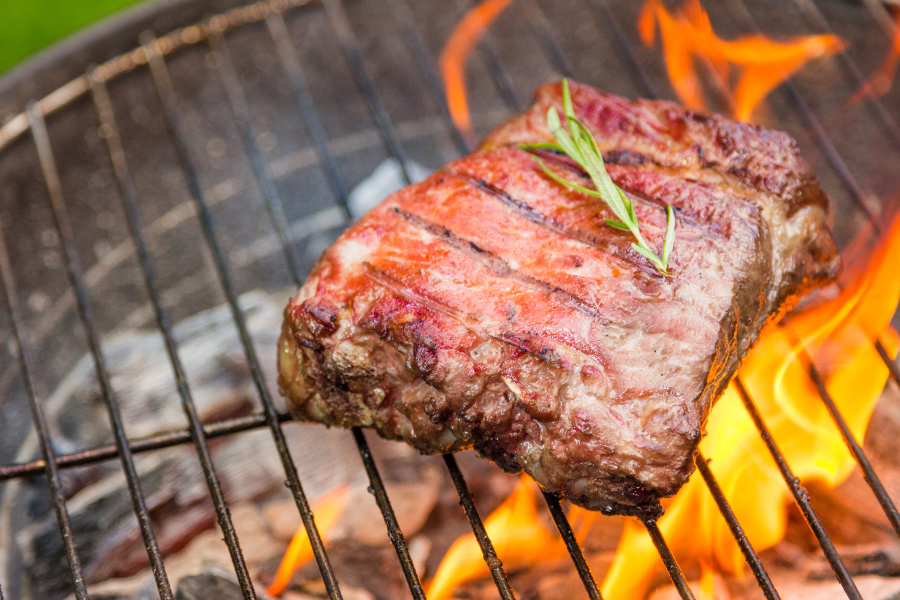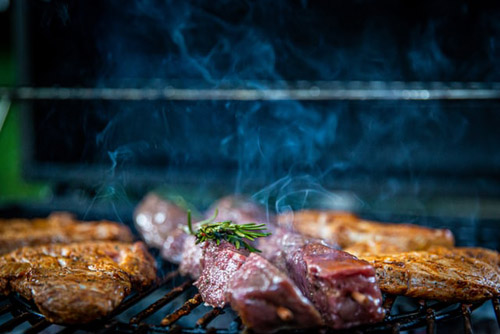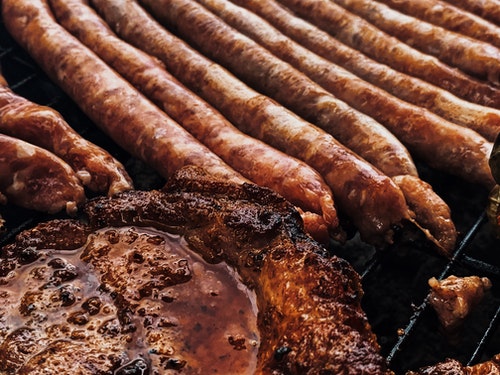The BBQ stall can put a crimp in your outdoor cooking event each and every time by delaying how long it takes to prepare your meat.
Fortunately for you, I have had years of barbecuing and smoking and can show you everything that you need to know about this phenomenon. Let’s begin!

I am a big believer in the science of cooking. This is because, at the end of the day, physics, chemistry, and biology all have an impact on food and cooking processes.
This is especially obvious when it comes to the dreaded stall. You might have heard of it or even experienced it yourself. So, what is it?
Well, it is a point in the cooking process where the meat hits an internal temperature of around 160 degrees Fahrenheit and then stops cooking. During this period, the temperature may not budge at all or may only go up by a few degrees.
The meat remains at this stall temperature for an extended period of time, delaying the cook.
The stall can happen to any type of meat – pork butt, pork shoulder, brisket, and more.

There are a lot of theories about what causes the stall.
Some people believe that a protein known as collagen is to blame. This is because at 160 F, a process known as the phase change begins to take place. This is when collagen combines with water and converts to smooth gelatin.
Others imagined that fat rendering was the cause. This is where lipids become liquid. It is another form of a phase change. There are also those who think that the stall is the result of protein denaturing. This is where the long chain molecues break apart.
Now, the reason that the above theories gained so much traction over the last few years is because each of these changes use energy in form of heat.
However, after some experimentation with briskets, pure beef fat, and sponges, the experts realized that this wasn’t what was happening.
Related Reading
Rather, it was identified that the stall occurs due to the evaporative cooling effect.
As you are aware, meat contains moisture in the form of water and other juices. When you first place the meat on the grill or smoker, the meat’s surface cooks first before the heat moves inward.
As the meat’s temperature rises, the liquids heat up as well, giving way to the evaporation process, turning it into gas. As this moisture evaporates, it cools the surface temperature and the stall hits.
Essentially, the temperature of the meat rises, along with the evaporation rate. This continues until the cooling effect balances out the heat surrounding the surface, causing the stall. Only once the final drop of moisture from the surface is gone – i.e when evaporative cooling is over – will the temperature rise once more.
It isn’t always clear when the stall has set in. This is because the stall temperature can vary from one situation to another. The temperature can be affected by the meat – the size, shape, how much moisture it contains, whether it has been injected with anything – and the type of cooker.
Related Reading
As a result, the stall can set in at any point between 150 degrees and 170 degrees. It is more common for it to begin when the meat hits around 160 degrees, however.
In this case, how do you know when the evaporative cooling is in full effect? Well, there is no way to be a hundred percent sure.
What you should do, though, is track the meat’s internal temperature. This will allow you to keep track of the cooking process.
As you do this, you have two choices. The first choice involves waiting for meat’s temperature to hit a certain point and then wait for anywhere from half an hour to an hour to determine if the temperature is rising or not.
Your other option is to wait for the meat to get to between 150 and 165 degrees and to tackle the stall. The second option may save you a little bit of time.
So, does the brisket or pork butt stall always take place? Well, not necessarily.
A higher interior temperature results in a shorter stall. At temperatures around 300 degrees Fahrenheit, evaporative cooling may not happen at all.
In case you are wondering why people don’t just start smoking meat at a higher temperature, the answer is simple. Most meats taste better with low and slow cooking.
Very high heat can end up drying the meat out, particularly with cuts such as the brisket flat – this has less fat than the brisket point.
You may also not experience a stall if you have an electric smoker. This is because there is a direct correlation between airflow and stall temperature. The more airflow there is, the lower the temp.
Electric smokers, however, tend to have a tight seal and tons of humidity inside. This cuts down on the airflow and causes the internal temperature of the smoker to rise more quickly.
Pellet smokers are pretty great at beating the stall as well. They are equipped with fans that create an environment similar to that of a convection oven. This speeds up the process of evaporative cooling, causing the stall to be shorter.
It is important to understand that the length of the stall can be impacted by various factors – these will be discussed below.
Therefore if you are wondering:
How long does the stall last when smoking Boston butt?
Or
How long does pulled pork stall?
The answer is difficult to define. On average, though, a stall ends after six hours.
Related Reading
As already mentioned, airflow and the level of sealing on the cooker can impact the stall. Here are some other elements that can have an effect on the length of a pork butt or brisket stall:
The size and surface area of your beef brisket or pork shoulder matters for two reasons. First, the greater the surface area, the greater the rate of evaporation. This means a longer stall time.
A big hunk of meat is also going to contain more moisture. Thus, there will more evaporation and this will result in the stall lasting longer.
There is also the added moisture content to think about. It isn’t unusual to inject the meat with water, a salt solution, or some other kind of liquid. This is typically done to stop the meat from drying out.
The only issue here is that this means that there is extra moisture in the meat, causing the stall to go on for a greater period.
To add to this, you may find some people spraying, mopping, or spritzing the surface of the meat. You then get a more moist surface – this cools down the area around the piece of meat, boosting the effect of evaporative cooling. This also ensures that there is more moisture evaporating.
Do you place a water pan in your smoker when smoking meat? A lot of people do this. This helps to regulate the interior temperature of the smokers. The liquid from the water pan also mixes with the smoke, boosting flavor transference and infusing the meat with smoke flavor.
The downside is that as this water evaporates, it can bring down the temperature of the smoker. In short, it increases the stall and cook time.
If you are thinking of skipping the water pan for your next cookout, though, I would urge you not to. Sure, it can cost you in terms of cooking time but when you consider the benefits, they outweigh the negatives by a lot.
So, go ahead and keep the water pan and use the below method to beat the stall instead!
Now, onto overcoming the stall! This is done via a method known as the Texas crutch. The name caught on with the competition circuit.
This is the process where once the meat starts to stall, it is removed from the smoker. You then wrap the meat in foil and pop it back in.

When the meat is wrapped, there is no real moisture loss. This is because the moisture is trapped within the confines of the wrapping. The steam gets hotter, allowing the meat to continue cooking at the same rate as it did before.
Related Reading
For the longest time, the meat was wrapped in foil for the Texas crutch. While this material is solid, it does have one downside. Foil creates an impenetrable barrier. This means that none of the moisture is allowed to escape.
While this does speed up the rate of cooking, it can also compromise the bark. Rather than being nice and crunchy, you end up with a surface texture that is slightly soft, even soggy.
This is why an increasing number of people have started using pink butcher paper. This is slightly porous, allowing for some of the steam to get out. While this does extend the time of the cook slightly – about half an hour or so, you do get a crunchier bark and a nice, tender texture on the inside.
Related Reading
Here is the main event – a step-by-step guide on how to wrap the meat. For this, you will need two sheets of heavy duty foil – this will ensure that it won’t tear – or butcher paper. Each sheet should be four times longer than the cut of meat is wire.
On your table or workstation, lay down one of the sheets. The long edge should run perpendicular to you. Place the second sheet on top so that it overlaps the first one by about half its width.
Place the meat on the sheets – it should be about one foot from the bottom edge. If you want to, you can spritz some liquid onto the meat or the paper. If you don’t want to dislodge the rub or the bark, I would suggest spritzing the sheets.
Fold the bottom edge of the sheet over the meat. Make sure that the material is pulled tightly against the meat – it should hug every angle of the outline.
Fold the side of the sheet over the meat, creating an obtuse angle. Smooth out the sheet. Repeat this step with the other side as well. Smooth this area down too.
Hold the wrap around the piece of meat on all sides. Roll the entire cut over. Then, fold in each of the sides as you did before.
Fold the top of the sheets so that it increases in thickness. Then, roll the meat over again.
In some cases, you may experience something known as the second stall. This may take place once the meat is already wrapped. If there is a tear in the material or if you have left any room for the heat and steam to escape, then the stall may occur once more.
To avoid this, make sure to wrap the meat tightly with every single step. When you are done, you should be able to clearly see the outlines of the cut.
It is also why you should use high-quality materials – they are less likely to tear or be compromised during any point of the cook.
You may be surprised to learn that not all pitmasters wrap meat. Only some, like Aaron Franklin, have adopted this methodology.
There is no denying that the Texas crutch is great for speeding up the smoking meat process. It is also ideal for ensuring that your meat will turn out juicy and tender, without constantly keeping an eye on it.
The main reason that there are detractors, though, is the bark. As mentioned earlier, the Texas crutch can compromise it a bit. And, for many pitmasters and barbecue enthusiasts, a crunchy, delicious surface is key to many good dishes, including brisket.
The other downside is that with the wrapping, not as much smoke penetrates the meat. As such, the smoky flavor isn’t as strong as it could be.
Now that you have the full story it is only natural to wonder – should you be using the Texas crutch?
Well, this is a decision that you are going to need to make for yourself. You should know that you don’t have to use this method if you don’t want to. As I’ve said, there are plenty of pros who skip this step.
If you don’t want to use wrapping, all you have to do is simply prepare for a longer cook. This means that you should plan for your meat to take around six hours or so longer to cook. Thus, you should get started early and make up for this lost time.
Remember that your meat also needs to rest for at least an hour – more is better. This should factor into your calculations when deciding when to start cooking.
Another trick that you can try, though, is to wait for a bit longer before wrapping the meat. Hold off until you have a nice, red or black bark. Waiting about an hour or so after the stall has set in can also allow the flavor to really set in.
What I would suggest is to test out each method for yourself. Get two smaller cuts of meat and try out each option. This will give you a better idea of the exact differences to expect.
You may discover that the Texas crutch produces great results or may decide that the old school method is the way to go. Either way, you will have a firm answer.
Here are some other ideas for getting over the stall:
As I already said, I am against cranking up the temperature to 300 degrees. That being said, you may want to increase it to 250 degrees. Although I am wary of smoking meat at 275 degrees, this is something that you can test out for yourself.
At these temperatures, you will not be able to stop the stall from happening, but you may be able to push through it faster.
If you have a cheaper model or if your smoker has seen better days, then the seal may be a bit loose. One sign of this is that a lot of smoke escapes while cooking.
In this case, you may want to look into replacing the gasket. This can improve the seal around the cooker’s main compartment.
This should be a basic of smoking meat but I know a lot of people who make this mistake. They keep opening the lid to check on how the meat is cooking. When you do this, though, you are causing hot air to go out and cold air to go in.
Thus, despite what you have set the cooker’s temperature to, you will end up lowering the interior temperature.
To prevent this from happening, use a thermometer or a meat probe. Make sure that whichever one you choose, you can view the internal temperature of the meat from outside. This way, the lid can stay shut during the entire cook.
Phew! As you can see, there is quite a bit to know about the barbecue stall. And, it is important to learn about it all. By understanding this phenomenon, you figure out how to overcome it and in the process, end up becoming a more seasoned BBQ master.